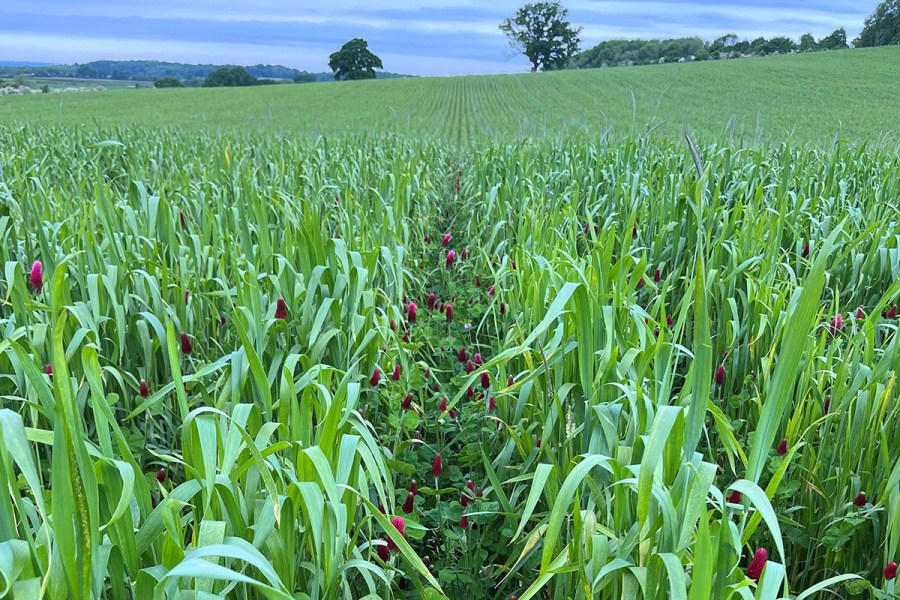Founder of Wildfarmed, Andy Cato, is turning food production on its head and driving change, both up and down the supply chain. CPM joins BASE on a visit to his farm in Wiltshire to find out more about farming the Wildfarmed way.
“Wildfarmed was founded from a sense that we don’t have much ecological road left.”
By Mike Abram
At Wildfarmed it’s not just wheat, it’s wheat grown with anything from pulses to crimson clover to phacelia to linseed, or even in herbal leys, for a premium market created from scratch in just three seasons.
What Andy Cato has already achieved with Wildfarmed is in many ways extraordinary, not least because he has no background in farming. Best known as a DJ and musician with band Groove Armada, he stumbled across an article about the environmental impact of food production on the way back from a gig in 2009. It both shocked and motivated him to grow and eventually sell his own vegetables, having never grown anything before.
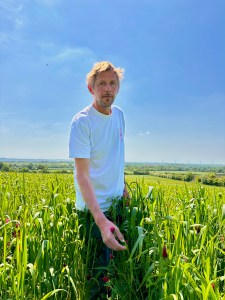
Andy Cato soon recognised that the market doesn’t value the system used to grow crops and that led to the foundation of the Wildfarmed community, which aims to grow crops in such a way there’s no trade-off between profitability and environment. Photo: Mike Abram.
It was the start of a remarkable journey that is now attempting to disrupt existing farming practices and change the way food is produced. “Wildfarmed was founded from a sense that we don’t have much ecological road left,” he explains.
“We have to change things at scale, quickly. Today, we have the techniques to grow crops in a way where there’s no trade-off between profitability and the environment.”
But making those techniques more mainstream involves both finding a community of farmers willing to make changes to their farming systems, and to find a community of customers supporting those farms, he stresses.
“There’s no question it’s a big switch. For decades, farmers have been pushed into a mindset of control, trying to suppress nature – apart from the one crop we’re trying to grow. Moving away to embrace a system where you are bringing in other species and getting natural systems working again is a big mindset shift.
“There is a real fear of loss of control to weeds. I’ve been through that and don’t underestimate it.”
That experience was on a 100ha farm in Gascony, France in the foothills of the Pyrenees, bought after selling the publishing rights to his back catalogue of songs. “My wife had doubts about my financial predictions that proved entirely correct,” he admits. “I was overwhelmed by the skills needed to be a farmer.”
His plan was to convert the 80-year-old, predominantly maize farm with 0.5% organic matter overnight to grow organic cereals. “Predictably it didn’t work.”
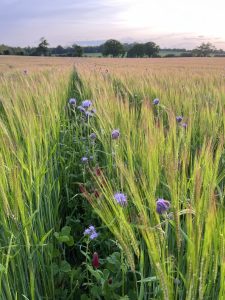
A feature of the Wildfarmed system is that the key focus is plant diversity within the crop, rather than just in field margins. Photo: Andy Cato, Wildfarmed.
On the verge of giving up, disillusioned, he came across Sir Albert Howard’s classic organic farming textbook ‘An Agricultural Testament’. With this, combined with Frank Newman Turner’s teachings on herbal leys and Rodale Institute’s advice on use of crimper rollers, he began practising mob grazing of herbal leys and planting soya beans into rolled down rye and maize into rolled down vetch.
Other experiments followed and he started to see a way to an organic minimum-till rotation. He then observed better recovery of soils under diverse herbal leys than in monocrops of vetch, maize, rye and soya.
This led to the idea of seeding cereals into herbal leys and then grazing with cattle late in spring to favour the cereal over the pasture – the concept of pasture cropping was born. “It wasn’t reliable enough to be a purely arable system, but worked well enough on a mixed farm, with some grass-fed beef to mop up the bits that didn’t work.”
After successfully producing cereals in the system, he was then faced with the issue Wildfarmed is hoping to address on a bigger scale – that the market doesn’t value the system used to grow crops. “I tried to add value by milling flour, but the bakers didn’t want to buy my flour, so I had to start baking my own bread.”
A farm shop followed, and the financial phoenix started to rise from the ashes, he says. Eventually, it led him to set up Wildfarmed in 2019, in conjunction with TV presenter George Lamb and financier Edd Lees. A move back to the UK has followed – he’s now a tenant of the National Trust on 300ha Colleymore Farm in Wiltshire.
Early attempts at pasture cropping in grass dominated pastures in the UK weren’t very successful, he admits. But then he came across Dr Christine Jones and her message about the importance of plant family diversity proved another potentially pivotal moment in the story of Wildfarmed.
“It changed everything in my head,” says Andy. “I’d been obsessed with pasture, but where I thought the reason that I was seeing faster soil recovery in the pastures, compared with crimping/rolling, was because the pasture was perennial. It was actually because it was a diverse sward of plants.
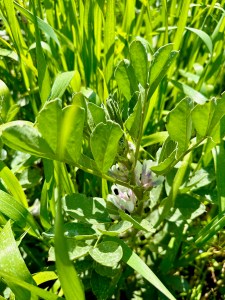
Growing cash crops with pulses or other companions is the first of five standards required to grow commercially for Wildfarmed. Photo: Mike Abram.
“As a result, we started building the Wildfarmed community around plant family diversity, with the key focus on plant diversity within the crop rather than just in field margins around the crops,” he explains. “This goes from growing wheat-beans bicrops to more complex polycrops.”
Growing cash crops with pulses or other companions is the first of five standards required to grow commercially for Wildfarmed. It’s also a requisite to grow a cover crop ahead of spring crops to minimise bare soil, while sap testing is used to make sure nutrition is based on crop need, with up to three sap analyses per season supplied and paid for by Wildfarmed.
Nitrogen is limited to a maximum of 80kgN/ha. Half of this can be supplied as granular N, with the rest as foliar applications, based on crop need. “The 40kgN/ha as granular in the spring is aimed at that critical spring growth period. It’s too early for sap testing and even if you wanted to use foliar applications, they wouldn’t be able to keep up with the needs of the plant if soil N reserves are insufficient, or the biology to release them is slow due to cold or wet weather. After that, we can base additional N applications on the established need of the plant.”
Allowing synthetic nutrition to be used was a challenge to his organic background, he admits. “I became persuaded by John Kempf’s argument that using targeted nutrition to optimise photosynthesis in order to drive soil recovery can be a really consequential gain.”
The limit of 80kgN/ha is based on two factors – first what is a reasonable yield expectation to take an alternative grain production system into mainstream agriculture, and second, the level of N that will optimise photosynthesis without damaging soil biology.
The ‘feed the world’ question has become so ingrained, any new system has to answer it, even if it’s a distraction, says Andy.
“We produce enough calories for 10 billion people. It’s a food distribution problem not a production problem, and the question assumes, against the evidence, that we can continue to do what we are doing.
“When drawing up the Wildfarmed Standards, we had to calculate what is a reasonable amount of grain from these kind of farming systems, which means we can go to retailers and say, if you do this at scale, you won’t have to import grain.
“It’s a complicated equation which involved Henry Dimbleby’s National Food Strategy observations on grain fed meat and the fact that our growers are producing cereals as bicrops alongside plant proteins. The numbers indicated that we need to target around 5.5 t/ha of wheat, with 1.5t/ha of the accompanying pulse, to build an alternative mainstream system.”
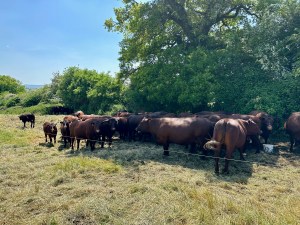
Mob grazing grass-fed beef forms part of Andy Cato’s enterprise at his farm in Wiltshire. Photo: Mike Abram.
While synthetic inputs of fertilisers can be used, no insecticides, fungicides or herbicides can be applied. That includes glyphosate, which if it were allowed would make recruiting farmers a lot easier, he acknowledges.
Blackgrass and other pernicious grassweeds are probably the biggest fear for growers without glyphosate, but Andy says feedback from Wildfarmed growers, so far, suggests that blackgrass is both lower in numbers and less competitive when it isn’t being fed by higher amounts of nitrogen.
Tillage, however, is allowed, prompting a debate over which is least damaging – glyphosate or cultivation. “I don’t know the answer,” says Andy. “The Rodale Institute, accepting it promotes organic agriculture, did a study comparing different farming systems for 40 years and found that thoughtful tillage is compatible with building soils in biologically rich systems.
“Andy Neal at Rothamsted spoke at our growers’ day recently and described a plot which is ploughed every year, but on which they also add a large amount of manure. Despite decades of continuous ploughing, the soil microbiome was like that of a forest. He explained that the problem with tillage is the carbon loss, and if you compensate that with carbon inputs then you can maintain the porosity and connectivity of the soil and keep it healthy.”
That prompts an as-yet unanswered question about the levels of tillage that can be offset by carbon sequestration in a Wildfarmed system, where there is diverse cover virtually all year.
To help answer the tillage versus glyphosate debate, Wildfarmed has commissioned some research with Rothamsted, where a cover crop has been destroyed using either cultivations, glyphosate, cultivations and glyphosate, or by ploughing before drilling a spring wheat.
“Rothamsted is taking soil microbiome analyses every fortnight through the growing season of the crop to see how the soil microbiome responds to different treatments and how quickly the glyphosate breaks down. We’re also going to analyse the grains for any glyphosate residues.
“If the outcome of the Rothamsted research is there are no glyphosate residues in the grain, and soil function emerges better from chemical rather than mechanical termination of the cover crop, then we will have to have a think about it, but until we have that information, we’re using the precautionary principle.”
Another factor is consumer and retailer messaging. “The word regenerative is being used more and more, and unfortunately is being applied to systems which aren’t regenerating much at all,” suggests Andy.
“This is why we created the Wildfarmed Standards – it’s critical that the momentum for change in the food system brings about a genuine transformation of our landscapes, and that we are clear about what we are doing.”
Communicating a complex message about the potential of biology-based farming to address public health, biodiversity and climate change to an urban population, largely divorced from its food supply, is difficult enough, without complicating it further with a nuanced message about tillage and glyphosate, says Andy.
Over the past three months, interest in Wildfarmed grains has gained significant momentum and the team hopes to double the area from the current 3000ha, grown by 55 growers in the UK and five in France.
From September, Wildfarmed will work on an annual grain contract within a three-year agreement. Growers can opt out if it isn’t working for them. “We want Wildfarmed to be accessible and not feel intimidating for growers. But on the other hand, we want it to be over a period which is meaningful, so farmers see changes and outcomes and experience being part of a community. Community support has emerged as being the most important part of the Wildfarmed project.”
The milling wheat spec is for a minimum 11% protein and 225 Hagberg. Wildfarmed growers are finding that a combination of lower yield and choosing varieties that can achieve a higher spec in low input systems means that this is achievable, even with the low N rates, says Andy.
Most Wildfarmed growers this season are growing a blend of German e-wheat Nelson, two Austrian wheats – Edelman and Ehogold, bred for achieving high milling quality – and UK-bred Group 2 Mayflower. All are suitable for low input systems. Blends of home-saved wheat could also be grown with Wildfarmed approval.
Wildfarmed takes the whole wheat crop on a produced area basis, whether it’s a bicrop with pulses or grown with companions such as crimson clover. The various components will be separated by Robin Appel.
“We deal with the separation, and then pay the agreed premium on the wheat. If you’ve grown beans, for example, that’s on a pool contract so you get a feed bean price currently, although we’re working on adding value to that. There is demand for traceable, non-soya animal protein.”
For harvest 2023, growers could choose between a fixed price of £310/t or opt for a percent premium above the market price at harvest. Most chose the fixed price.
Last year, winter wheat at Wildfarmed’s home farms averaged 3.5t/ha (see table) without the use of any applied nitrogen (this predated the updated Wildfarmed Standards use of targeted nutrition including 80kgN/ha). Andy estimates the use of N this season will boost yield by 2t/ha, leaving a slightly higher gross margin of £1337/ha, despite higher input costs and lower wheat price.
By comparison, the latest edition of the John Nix Pocketbook suggests a gross margin for conventionally produced feed wheat of £1200/ha. Other crops that can be grown for Wildfarmed are spring wheat and spring barley, with oats likely to follow in the future.
Market opportunities
Creating a market so quickly for Wildfarmed grains is perhaps an even bigger achievement that persuading growers to grow cereals with companions, without glyphosate and small amounts of nitrogen.
The firm has around 400 customers, from artisan bakers to restaurants and retailers. While many of those are premium brands, such as Harrods, Selfridges, Fortnum & Mason and Heston Blumenthal’s Fat Duck, the focus from the beginning has been the high street, he says. “We have to make this mainstream; it’s got to be food for everyone.”
The first high street supermarket to come on board is Marks & Spencer, producing various products using, on average, 60% Wildfarmed flour. “We want to make sure there are affordable products that nevertheless allow consumers to support these kind of farming practices and help drive landscape change,” says Andy.
That has taken a great deal of effort, including multiple visits to the farm. “High street retailers are incredibly complicated businesses, with many different departments, and third-party suppliers who are often on tight margins themselves and so, for them, changes in ingredients are challenging. It requires time and farm visits to build relationships, nothing happens overnight.”
Wildfarmed in practice
Constant experimentation and adaptation have been part of Andy Cato’s farming life pretty much since he started. That hasn’t changed at Colleymore Farm, where he’s trying to balance paying the rent and find practices that can be recommended to Wildfarmed growers.
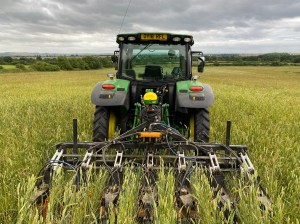
Andy Cato’s interrow mower design has been replicated for others in the Wildfarmed community, who are using it to manage different kinds of relay-cropping systems.
Photo: Andy Cato, Wildfarmed.
Last autumn his focus was on seeing whether crimson clover could be used as an alternative legume to winter beans, which would allow winter wheat to be drilled earlier and potentially enable other companions to be grown as well.
In France, he grew crimson clover with rye without any problems with either maturity or grain/seed separation, so Andy thinks it should be possible to do the same with wheat.
While it hasn’t gone completely to plan so far, with a drill issue meaning that some of the crimson clover wasn’t drilled into the interrow as well as planned, the option does look promising if the maturities match in UK conditions.
The weed issues left by imperfect crimson cover establishment have meant using a purpose-built interrow mower between the rows to manage them, as employed his pasture cropping system. He hopes that with a better coverage of crimson clover in the interrow space, it won’t be necessary going forward.
“Getting good establishment in the interrow is critical in order to make sure we’re achieving plant diversity and fertility building,” says Andy. With this in mind, his experiments this autumn will include a Landwrx interrow drill to establish the small seed companions in September, before coming back later to drill the wheat.
In his pasture cropping system, mowing between the cereal rows to manage the herbal growth and competitions is a crucial part, letting the wheat get ahead. Andy’s interrow mower design has been replicated for others in the Wildfarmed community, who are using it to manage different kinds of relay-cropping systems.
The vast majority of Wildfarmed growers currently use their existing equipment to grow bi-crops, such as wheat and beans or barley and peas, with cover crops ahead of spring crops. “Elements of what we are experimenting with at Colleymore will perhaps open up further opportunities for our growers in the future,” he concludes.
Farming the Wildfarmed way
With many aspects of the Wildfarmed approach already part of the regenerative system at Whitbread Farms, near Biggleswade in Bedfordshire, it wasn’t a difficult decision to dip a toe in the water with a small area for the current growing season, says farm manager Mike Purnell.
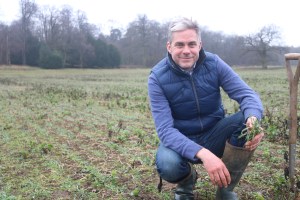
Mike Purnells sees three potential barriers to growing for Wildfarmed more extensively on the 1000ha farm; rotation, returns, and weed control.
“We were already doing a lot of the requirements – bicropping, using companion crops, no insecticides, increasing diversity and reducing inputs. We grow beans and wheat or oats together, so we don’t put on fertiliser anyway, and there are no herbicides or fungicides we can use.”
His 10ha Wildfarmed field was established in October in two passes as he doesn’t own a multi-compartment drill – the first pass put in winter beans, relatively deep, while the second sowed wheat at an angle a day later.
“It looks well now,” he says. “I was worried in early spring because of the number of broadleaf weeds at the bottom of the crop where we have thin patches. But the thin patches in my conventional beans are also weedy. A thicker crop in both fields has smothered the weeds now.”
Mike sees three potential barriers to growing for Wildfarmed more extensively on the 1000ha farm and one of these is rotation. “It’s trying to fit their relatively limited rotation into my seven-year rotation, which involves oilseed rape and some other crops they don’t have a market for currently.”
Returns are the second barrier – last year he grew 9.5t/ha of Group One milling wheat. “Lower inputs are a good thing for everybody, but ultimately, we have to make money. Reducing variable costs can’t to the detriment of margin.”
The last barrier is weed control, and especially creating sterile seedbeds. “That’s the big sticking point. If you have blackgrass at establishment, then what hope is there for the rest of the season?”
Mike would prefer to have the option to use glyphosate pre-crop. “My view is that one carefully timed, buffered application of glyphosate is better than cultivation, but it’s very nuanced and everybody has a different opinion.”
This article was taken from the latest issue of CPM. For more articles like this, subscribe here.
Sign up for Crop Production Magazine’s FREE e-newsletter here.

